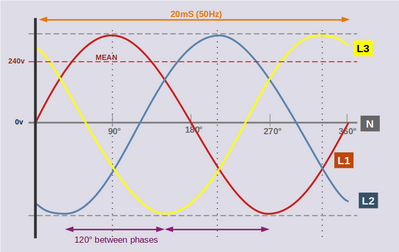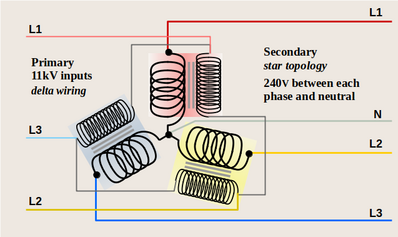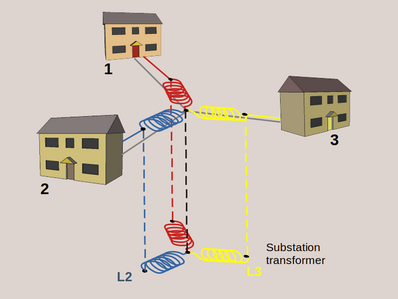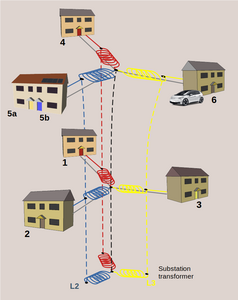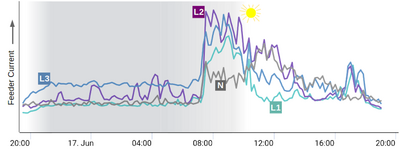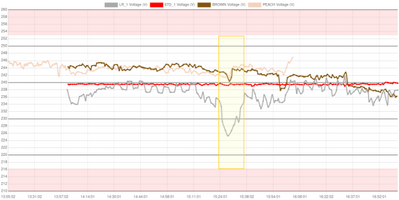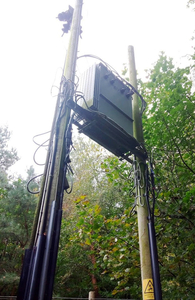What crazy nonsense are inverter limits and why are they imposed?
Posted by: @transparentMy apologies @batpred I overlooked that you'd already I identified your DNO as being UKPN.
So you are more likely to be in an area where 5kW export could be permitted.
Continuing this here as it is related to dno approvals. Anyone needing the background, it is at the fogstar/solis adventure. The eventual grounding of my dreams for HA optimisation may also fit elsewhere.
When you said I am in an area that allows 5kw single phase, does it mean the DNO have some ability to even it across phases?
As it does not make much sense unless the phase would extend to a very large number of households. I am thinking the # households is restricted by distance on a low density housing setting like mine.
I would be exporting when the agile rate in my region justifies it, not when whoever is on the same phase at local level needs it.
Or is this 5kw capable area going to do something clever to balance power across phases?
16kWh Seplos Fogstar battery; 8kW Solis S6-EH1P8K-L-PLUS hybrid inverter; Ohme Home Pro EV charger; 100Amp head, HA lab on mini PC
Is there a lookup facility to see your limit, or is it just on the original approval document, and can you apply for a limit increase, if for example you expand your system import/export, 16kW battery or even additional batteries, expansion in additional solar panels lets say 8 x 500W panels so 3kW to 4kW extra, 12kW+ heat pump, all electric cooker/hob, EV etc?
This is mine:
Posted by: @dreiIs there a lookup facility to see your limit
With my dno, there's a portal with accounts etc and some "applications" like the ev charger are just a few clicks.
Others you send docs like for export g99, etc and my dno updates it in the portal.
But essentially consumption is not really limited. I get 100amp, so 24kw service.
The way each dno handles requests for export depends on their infra covering your area and overall capacity. The power side of the system works in three phases (4 wires) and it is not common for domestic to take all of that in, specially on urban settings.
Essentially I take one phase and neutral wires. When I start exporting, it will just go via those wires. Only large renewable capacity need to be on dedicated three phase connections.
So what happens with the grid is that, when power is exported to one phase, it should be consumed in that phase, otherwise it may be lost. I do not work for the grid, there are competent people developing strategies for and also managing that stuff..
16kWh Seplos Fogstar battery; 8kW Solis S6-EH1P8K-L-PLUS hybrid inverter; Ohme Home Pro EV charger; 100Amp head, HA lab on mini PC
Posted by: @batpredThe power side of the system works in three phases (4 wires)
That's true for the LV (Low Voltage) level of the grid, which operates at 440v (3ph) and 240v between phase and neutral.
It's not true for all the rest of the grid because there's no neutral.
The national grid is a 3-wire system.
Posted by: @batpredEssentially I take one phase and neutral wires. When I start exporting, it will just go via those wires.
That's not how a 3-phase feed works.
If the load across all three phases is the same, then there will be zero current in the neutral wire.
The problem for local substations supplying (single-phase) housing is that the demand will be different on each house.
When the number of houses connected to a Feed cable is small, there is likely be a greater difference in demand between the phase.
That's called phase-imbalance, and is a serious problem.
In the following diagram, imagine the current being taken by each house is represented as the length of a spring:
The demand from the three houses above is the same.
There is no current traveling on the black neutral wire in the centre.
Lets add four more houses further along the road:
There's increased load from houses 5a and 5b which results in that blue spring being stretched.
But the greater effect is from the EV being charged at No.6.
This greatly increases the current being drawn along the phase coloured yellow.
Notice how the Neutral is also now being pulled off-centre.
It will be carrying current back to the centre-tap of the substation transformer.
Posted by: @batpredwhen power is exported to one phase, it should be consumed in that phase, otherwise it may be lost.
Energy is neither created nor destroyed.
Electricity you've exported from a house can't be 'lost'.
Either other houses on the same phase will use the electricity you've exported,
or else the phase-imbalance will generate heat in the substation transformer.
Losses due to phase imbalance in Britain are currently running at 10%, which is a massive waste.
When I view timelines from local substations, I can 'see' phase imbalance occurring by looking at current in the neutral.
The two concepts are directly linked.
In the above plot you can see households 'waking up'.
Demand increases significantly just before 8am.
There's light cloud in the area until 10:30.
At that point sunlight hits solar panels on rooftops.
But houses on the phase coloured turquoise (L1) have more solar export.
They make less demand on the grid, which is why the L1 current falls more.
The result is a rapid increase of current flowing in the neutral (grey).
Once you understand the concepts above, it becomes possible to appreciate why there are particular limits on the permissible export from properties.
Earlier this year I wouldn't have bothered correcting your statements.
But we now have an AI bot picking up information from this forum.
Wattson then offers that information to other people.
We can no longer allow inadequate explanations to remain unchallenged.
Save energy... recycle electrons!
Thank you for a very comprehensive, timeless and rounded explanation, that gets to the core of the title of the thread.
No problem at all, and even if there were corrections. A few lines could only be based on a simplified model.
16kWh Seplos Fogstar battery; 8kW Solis S6-EH1P8K-L-PLUS hybrid inverter; Ohme Home Pro EV charger; 100Amp head, HA lab on mini PC
So by that principle, during the Octopus Free Sessions when I maximise all I can, including pushing the heat pump to draw up to 6kw, battery 6kw, appliances washing and what not, plus one or two electrical radiators, space heaters... my string is pretty damn stretched.
When I produce more solar power than I use, does it go to all the houses around mine that need it, or does it go to the grid then back to those houses? Wouldn't electricity take the shortest path and be drawn by my neighbour? From what I can tell, before I had my panels, I used google maps to check others, and can't see a great number of solar panels. I would say that out of 100 house, maybe 5 have panels.
If you’re interested in finding out which of your neighbours is on the same colour as you, get a mains driven baby monitor and play music on it, then visit your neighbours and plug in the receiver; if you hear the music, you’re on the same phase.
My home assistant plots some simple graphs of the voltage of my grid. It is never the same!
No idea if when we export it goes beyond our nearest neighbours.. a properly incentivised dno should be on top of that..
16kWh Seplos Fogstar battery; 8kW Solis S6-EH1P8K-L-PLUS hybrid inverter; Ohme Home Pro EV charger; 100Amp head, HA lab on mini PC
Posted by: @batpredMy home assistant plots some simple graphs of the voltage of my grid. It is never the same!
The same as what?
Do you mean that it continuously varies according to demand by houses connected to that local substation?
Because that's what you'd expect it to do of course!
And it will also vary according to the loading on the 11kV grid which supplies local substations.
If I plot a timeline of grid voltage taken from three LV monitors which are on different 11kV lines from the same Primary Substation,
I can see some variations which are common to all 3 locations.
That's where the voltage is affected by supply/demand over the wider region, possibly at 33kV or above.
The yellow highlighter box shows a voltage-dip due to a demand surge which affects the location of the Grey Monitor to a greater extent than Brown or Peach.
After a few months of running tests across the area covered by my own Primary Substation, I can now 'see' when cloud-cover has suddenly reduced solar generation
at a couple of villages over 5-miles away!
Posted by: @batpredNo idea if when we export it goes beyond our nearest neighbours.. a properly incentivised dno should be on top of that..
The DNOs Network Planners have in-house software which they use to estimate the likely effect of export to the grid when you make an application.
A similar software tool is used for LCT Applications (EV chargers and heat pumps).
But it's very unlikely that the DNO would know the actual grid voltages on their 11kV and LV levels.
I occasionally tell them what I find!
Amongst the factors which they input to their software calculator are
- distance between your house and the local substation
- total number of properties on that local sub-station
- the number of houses between you and the substation (divided by 3 to estimate the number on your phase)
- the conductor material your LV feed is made from (copper or aluminium)
- cross-sectional area of the conductors
Do you get the idea?
Save energy... recycle electrons!
Posted by: @transparentPosted by: @batpredNo idea if when we export it goes beyond our nearest neighbours.. a properly incentivised dno should be on top of that..
But it's very unlikely that the DNO would know the actual grid voltages on their 11kV and LV levels.
I occasionally tell them what I find!
That's exactly what is expected, that voltage etc will vary. But how can the DNO keep it within specific quality parameters, unless they monitor it?
Posted by: @batpredAmongst the factors which they input to their software calculator are
...
Do you get the idea?
What the folks were asking is if these components are smart enough to balance some aspects in near real time. Or monitor it, so they could take the peaks and troughs into account..
This is probably different in different parts of the DNO grid anyway.
Anyway, I'd better get back to work!
16kWh Seplos Fogstar battery; 8kW Solis S6-EH1P8K-L-PLUS hybrid inverter; Ohme Home Pro EV charger; 100Amp head, HA lab on mini PC
Posted by: @batpredBut how can the DNO keep it within specific quality parameters, unless they monitor it?
Let's first note what those parameters are.
They are defined by Sect.27 of the Electricity Regulations 2002.
Historically DNOs have maintained the voltage bands by simply having greater grid capacity than is required.
The physical grid is 'over-sized' and hence it takes a pretty massive 'event' to pull the grid outside specification.
But us consumers have to fund grid upgrades, and an overly-large capacity would cost Britain more than it can afford as we progress to 2050.
Electrification of domestic heating and transport is a key component of the Net Zero strategy.
We can't afford to monitor the lower levels of the grid.
It's not just the cost of fitting monitoring apparatus, but also creating the data-gathering comms network, with large data servers,
and a wide array of software tools to analyse the data trends and tell engineers what they need to know.
When I was first allowed access to a single grid monitor in 2018, I was receiving half-hour packages which gave me figures on 146 different measurements.
Some were averages over that 30-mins, whilst others were maxima or minima, according to what was the parameter being measured.
If I'd wanted to, I could've received data packages per minute, which was the granularity being held by the server.
That's a stunningly large quantity of data to handle if DNOs were to be incentivised to collect it!
In GB there are 230,000 ground-mounted local substations (11kV input)
and another 320,000 which are pole-mounted.
Many of the pole-mounted transformers are no less massive than those in ground-level compounds.
Typically you'd find them serving country estates, such as those owned by the National Trust.
It was the early experiments undertaken by the wealthy landowners of those estates which enabled engineers to calculate what was
required in order to light our towns and cities.
A landowner would install a primitive hydro-electric generator on a river in the estate, and run the output to a room-sized consumer unit
in the cellar of his house:
If there are going to be voltage variations on the grid which take it outside of the statutory limits, then it's more likely that they'll
be occurring in the furthest reaches of the network.
A commercial operation to measure and record that data would be monumental in size and cost.
Posted by: @batpredWhat the folks were asking is if these components are smart enough to balance some aspects in near real time.
Or monitor it, so they could take the peaks and troughs into account..
I'm sure the DNOs would love to have such a requirement put onto them.
The work would keep thousands of new engineers in work for a decade or more...
... and allow third-party Energy Agents to license that data in order to directly control our household appliances!
That's what the Smart & Secure Electricity System (SSES) team of civil servants are busy developing within DESNZ.
They intend allowing licensed agents to turn off domestic heat pumps during periods of high (national) demand.
However, domestic appliances are connected to the LV level of the grid, whilst national demand statistics are done at 275kv - 400kV.
You cannot mathematically extrapolate sensible interpretation and derive control algorithms at the two extreme ends of the electricity supply network.
I doubt that DESNZ had ever seen LV monitoring data before embarking on their mission, now dubbed "Consumer Led Flexibility" or CLF.
But I've had years of reading and interpreting such data.
So I bundled up a representative sample, wrote explanatory text, and sent it to them four weeks ago.
I do know how to use sparse data from a monitored grid to benefit demand-loading on the LV grid.
As a consumer, I'm a 'free thinker' and can consider all possibilities,
whereas the energy sector is based on how much profit can be made.
That's unlikely to reach a workable solution.
We discussed these issues extensively on the Heat Battery topic which was started by @wully
Save energy... recycle electrons!
- 26 Forums
- 2,356 Topics
- 53.4 K Posts
- 327 Online
- 6,017 Members
Join Us!
Worth Watching
Latest Posts
-

RE: Controlling Daikin Altherma via P1P2 and Home Assistant
On the contrary, @toodles, that’s a lot of help. I’d ne...
By Majordennisbloodnok , 1 hour ago
-
RE: Octopus Cosy Heat Pump Owners & Discussion Thread
@kevh with the Cosy 6 I know it definitely goes to arou...
By HarrisonC , 14 hours ago
-
RE: Setback savings - fact or fiction?
@cathoderay yes I am familiar with SQL. Interesting num...
By RobS , 15 hours ago
-

Parsnip, Bacon & Coconut Milk Soup
First let me say, I am only a cook because I am human a...
By Toodles , 15 hours ago
-
RE: Electricity price predictions
Ben Watts posted on LinkedIn that he had updated this w...
By Judith , 20 hours ago
-

RE: The good, the bad and the not that great – my heat pump installation
Small update, Emailed and Spoke to Midea UK and they ...
By Burtis , 21 hours ago
-
RE: Solis S6-EH1P8K-L-PLUS – Why I Chose It and What I’ve Learned So Far
@bash Octopus does charge for the admin. The process al...
By Batpred , 21 hours ago
-
RE: External pipework insulation
@transparent HI all The products you mention are ver...
By David Smith , 21 hours ago
-
RE: New Fogstar 15.5kWh upright solution
Issues still under investigation by Solis... Fogstar ...
By Batpred , 21 hours ago
-
RE: Who's your electricity provider and what's your tariff?
I agree, the consumer is not being properly represented...
By Batpred , 21 hours ago
-
RE: Advice on internal circulation pump noise
Thanks @mikefl - I'll maybe have a look at the lock-shi...
By jtg , 2 days ago
-

RE: Heat Pump Heats the House… But It’s Not Cosy. Emitter Changes or System Tweak?
@toodles interesting suggestion, thanks. I will try to...
By GrahamF , 2 days ago
-
RE: Mitsubishi Ecodan Auto Adaption trial to stop cycling.
The interval you talk of, i think, will be 60min for an...
By F1p , 2 days ago
-
Agree with @majordennisbloodnok on the setbacks. We hav...
By ChandyKris , 3 days ago
-

RE: Speedcomfort radiator fans
@deltona the way the links were added broke the page. A...
By Mars , 3 days ago
-

RE: Refrigerant R32, is it now banned in the EU from 1st Jan 2027 for monobloc ASHPs?
This has been delayed from what I believe to be this ye...
By dgclimatecontrol , 3 days ago
-
RE: Are We Sleepwalking Into Another Race to the Bottom?
this is why I provided current flow temperatures in the...
By ksim , 3 days ago
-

RE: Why Millions of UK Homes Struggle With Heat Pumps
There's many homes that would be quite a disruption for...
By dgclimatecontrol , 3 days ago



